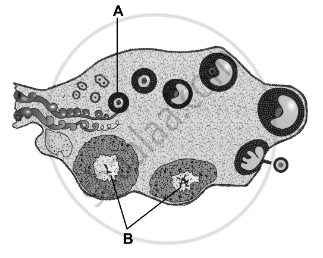Advertisements
Advertisements
प्रश्न
Observe the figure and label it properly.

- Name the hormone that regulates the cycle.
- Name the phases in this cycle.
- What is the duration of ovulation phase?
- What happens if implantation occurs?
- What happens if implantation does not occur?
उत्तर

- The menstrual cycle is a natural process, controlled by four hormones. Those four hormones are follicle-stimulating hormone (FSH), luteinizing hormone (LH), estrogen, and progesterone.
- The cycle consists of three phases-menstrual phase, the proliferative phase, and secretory phase.
- 14 days.
- If the embryo is implanted, repetition of this cycle is temporarily stopped till the parturition and thereafter period of breastfeeding.
- If oocyte is not fertilized within 24 hours, corpus luteum becomes inactive and transforms into corpus Albicans. Due to this, secretion of estrogen and progesterone stops completely. Endometrium starts to degenerate in absence of these two hormones.
APPEARS IN
संबंधित प्रश्न
Explain the menstrual phase in a human female. State the levels of ovarian and pituitary hormones during this phase.
Describe the roles of pituitary and ovarian hormones during the menstrual cycle in a human female.
Name the function of the following:
Corpus luteum
Choose the correct answer from the four options given below :
On which day of the menstrual cycle does ovulation take place ?
What is the menstrual cycle?
If the corpus luteum is present in the ovary even after 72 hours after ovulationit indicates that ______.
Match the Columns.
| Column I | Column II | ||
| i. | Proliferative phase | a. | Breakdown of the endometrial lining |
| ii. | Secretory phase | b. | Follicular phase |
| iii. | Menstruation | c. | Luteal phase |
Which hormone is secreted by the developing secondary follicles?
All occur during follicular phase of menstrual cycle, EXCEPT
____________ is transformed to corpus luteum during luteal phase of the menstrual cycle.
Calculate the expected date of ovulation, if in a normal menstruating woman, gets her menses on 5th April.
A biology student after studying the different levels of hormones during the menstrual cycle was comparing 2 subjects (Patients). A table was created after looking at the levels of hormones A and B for Subjects 1 and 2. Read the information in the table and answer the question that follows.
| HORMONE A | HORMONE B | |
| Subject 1 | Shows a peak on the 14th Day of the menstrual cycle. | Falls down during the luteal phase. |
| Subject 2 | Shows a peak on the 14th Day of the menstrual cycle. | The level is maintained high in the luteal phase. |
Subject 2 has a higher level of hormone B, which is ______
Distinguish between pollination and fertilisation. Mention the site and product of fertilisation in a flower.
Draw a neat, labelled diagram of a pistil showing pollen tube growth and its entry into the ovule.
Menstruation normally occurs once in ______.
The menstrual cycle begins with ______
Why are menstrual cycles absent during pregnancy?
What role does pituitary gonadotropins play during follicular and ovulatory phases of menstrual cycle? Explain the shifts in steroidal secretions.
The figure show a section of human ovary. Select the option which gives the correct identification of either A or B with function/characteristic.

Write a short note on Proliferative Phase.
